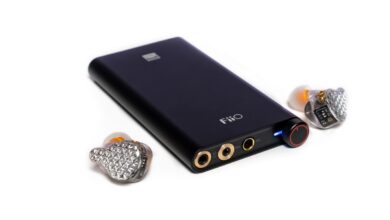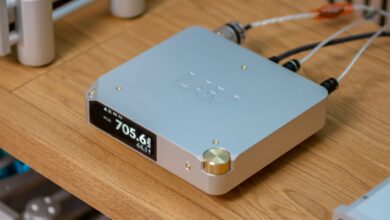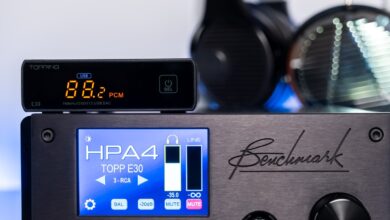
My Video Review:
Ah…the sound of a high-quality R2R DAC after a sea of chip-based Delta-Sigma converters feels like tasting an aged single malt whiskey for the first time. That deep, velvety smooth, indulgently sweet aroma reminiscent of French patisserie and a long-lasting aftertaste can’t be confused with your average $10 bottle of whisky. When delta-sigma D/A converters came into existence, they wanted to replicate the sound of well-thought R-2R ladder DACs at a fraction of the cost. When transistors came to conquer the world, they wanted to replace vacuum-tubes for the same reason…but did they actually succeed in approaching or surpassing their masters? There isn’t an easy answer… for some it’s a strong Yes, for others it’s solid No.
I’m fascinated by all those technologies and that is the reason I will always have at least an FPGA multibit, delta-sigma and an R-2R ladder DAC in my house no matter what. While chip-based delta-sigma and FPGA software-defined DACs already caught and sometimes surpassed the resolution and dynamic range of R-2R DACs, they never could replicate their long-lasting aroma, natural textures, smooth decays, beautiful overtones and simpler things like reproducing the pitch of the human voice. Don’t get me started with piano or cymbals, those are hard to be replicated with such devices and it’s a child’s play with R-2R units. There is something that is unmeasurable even by the world’s best Audio Analyzers and I can’t put my finger on it. There are plenty of R2R DAC manufacturers today, from affordable units like Audio-GD, MHDT Labs, Schiit Audio, Denafrips, Metrum, Border Patrol and Soekris, to mid-level devices like Holo Audio, CAD, LessLoss, TotalDAC, Lampizator, Mojo Audio and then to high-end units like Rockna, MSB Audio, Aries Cerat, Audio Note, CH Precision and others. There is almost something for every pocket. The biggest problem is that a high-quality R-2R unit with little to no compromises starts at around $3000 and everything below that point, seriously lacks precision and resolution. When Musician Audio came into existence last year, they wanted to completely alter that formula, bend to their will a decades long wrong preconception and I truly believe they succeeded. Their first-born Pegasus R-2R ladder DAC seriously impressed me with its clever component selection, good power supply implementation, high-quality resistors and outstanding sonics at only $1100. I say only because with R2R, that is actually an entry-level price.
One year later, they added not one, but two additional converters in their portfolio, challenging the notion of entry-level one last time and firing alarming shots into the high-end R2R crowd. At this very moment, Musician Draco is the most affordable true R-2R ladder DAC there is, with balanced and single-ended outputs, equipped with every possible digital input, there is nothing that is competing with it at only $685 and I mean it. But today…is a much cooler day, as I will be testing their best of the best, their Magnus Opus and crème de la crème. With Aquarius, this team wanted to express their genius, crafting a high-quality converter with the best components they had on their hands. This is overkill in every possible way, spotting an outstanding power supply design, the best-in-class audio-grade capacitors, high-precision femto-second clocks, two FPGA chips and for the first time: Four R-2R ladders in a fully-balanced configuration using only hand-picked and highest grade 0.005% precision resistors. In some ways, Aquarius has an unlimited potential and I can’t wait to tell you more about it. Musician Aquarius goes for $2899; so far this is their statement unit, so I’ll prepare an in-depth look for it. Before I move on to sound impressions, let’s unbox this bad-boy and see what’s inside.
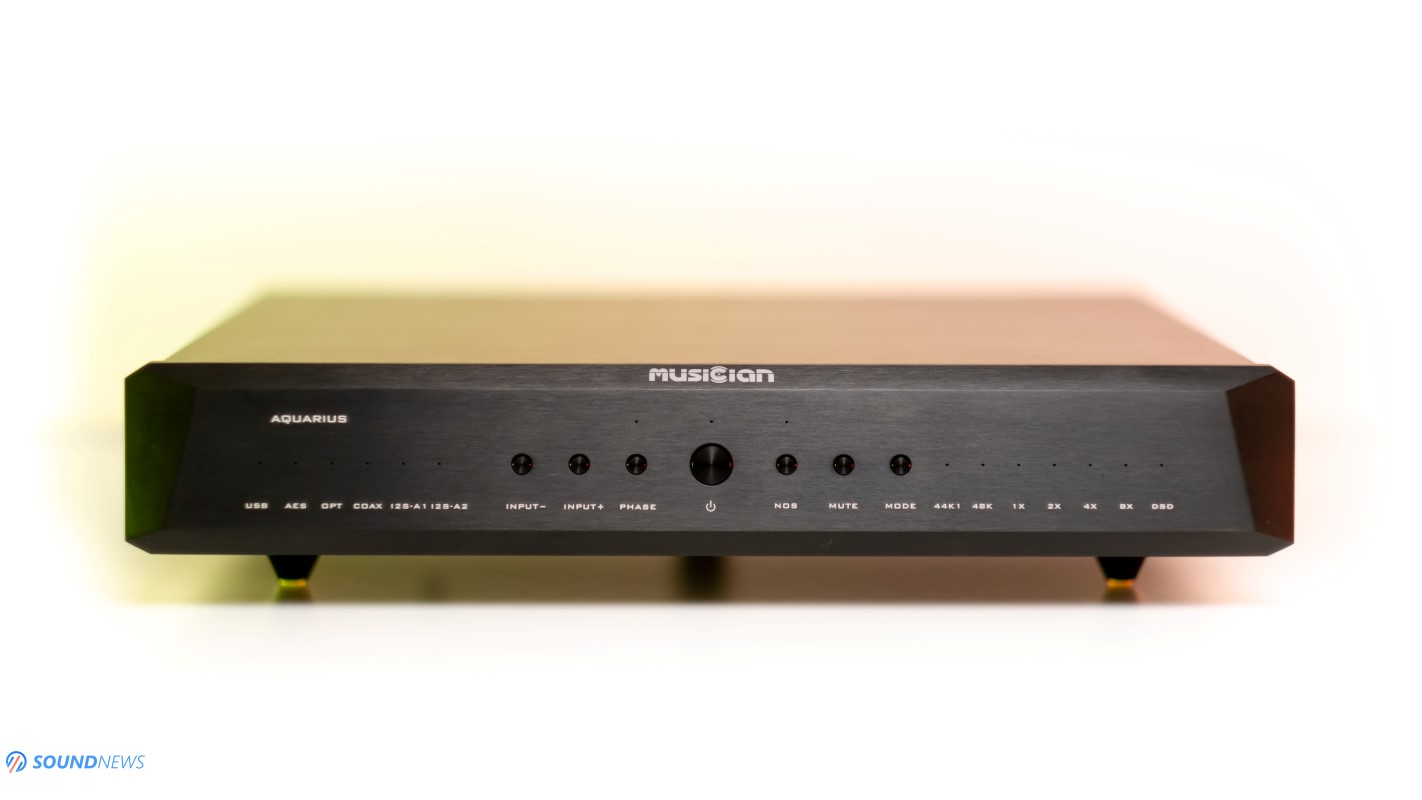
Unboxing & Package Contents
Aquarius came in the mothership of all boxes; I was already expecting a heavier unit, but seriously now, there aren’t small and lightweight R2R ladder DACs due to their complicated layout and number of internal components. Aquarius was surrounded by an absurd amount of foam for extra protection, with 8 pieces of plastic keeping the foam together like a sandwich. You should sleep tight, as it can’t be damaged during shipping with such an overly protective packaging. Inside you’ll find only a warranty card and a user manual, nothing more and nothing less. Since I’m testing the world’s first unit, the user manual wasn’t ready at that time, but it can be downloaded from their website, together with the latest USB drivers if you’re using it with a Windows machine. All their R2R units, including Aquarius are pure DACs at heart and as such, it doesn’t come with a remote control and it doesn’t offer preamp functionalities. With this said, I’m yet to test an R2R DAC with volume control; as each one of them didn’t have such a feature.
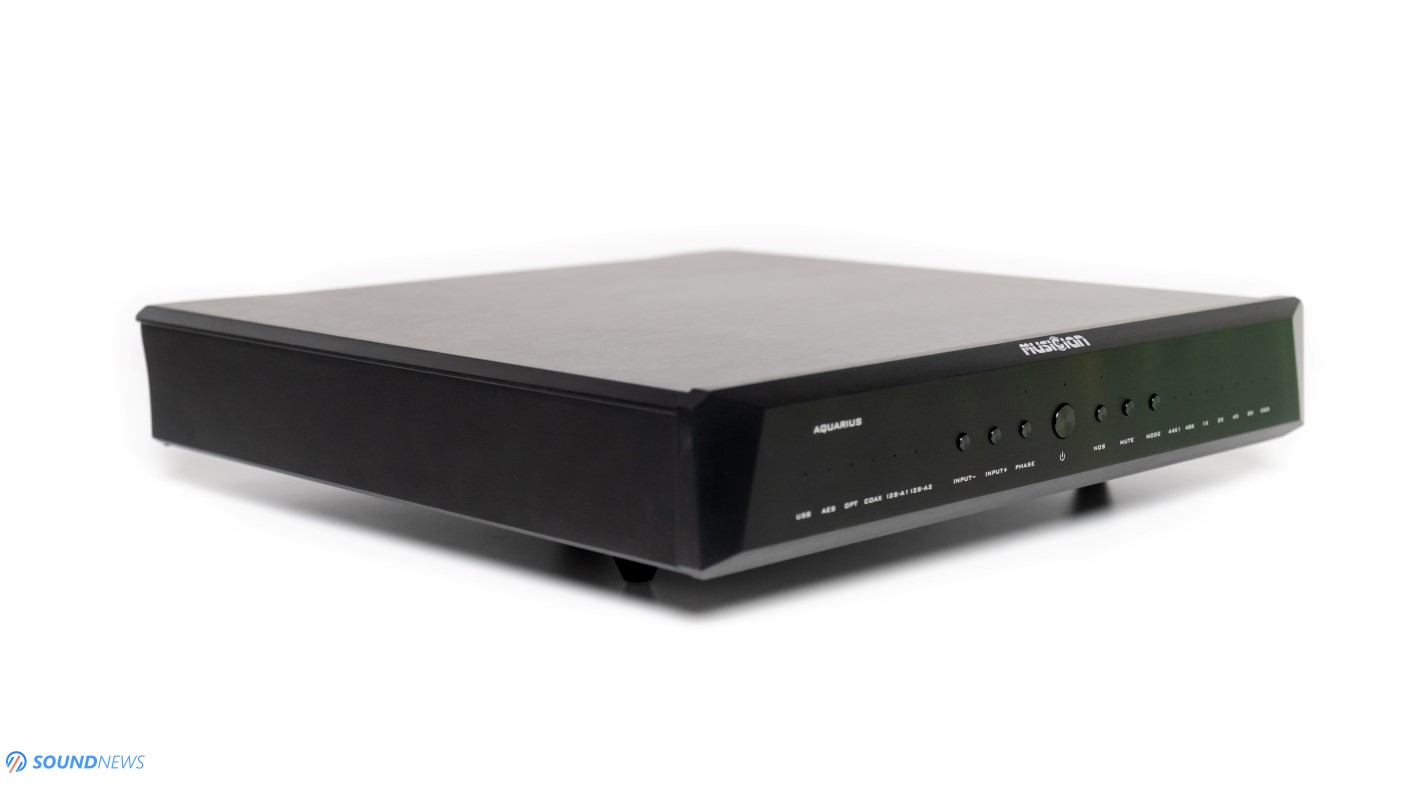
Design and Build Quality
Aquarius borrows the same design cues of its smaller sibling; it is just much heavier, bolder looking, wider and deeper. It follows the same design language and that’s a good thing, since I always liked the sleek and minimalist look of its predecessor. It uses CNC machined oversized metal plates on all sides, it will easily protect the precious unit from all wireless interference, including EMI and RFI.
Musician team equipped it with one of the best metal feet I’ve seen on D/A converters, with silicon absorption pads that will effectively absorb micro-vibrations. The front plate has a thickness of 1.5 cm and its overall structure feels solid and well put together, exactly how a high-end DAC should look and feel. Half of my music listening is happening in my office via a TOTL headphone setup, where a powerful 8-antenna wireless router is located, luckily Aquarius isn’t picking any of that nasty wireless interference with its impenetrable warship case.
As with most modern DACs, all the screws were moved on its back-plate for a much cleaner and elegant look. On the front panel I am spotting low intensity LEDs that will not bother in a dark environment. I’ve got the matte-black anodized version; the Musician team is also offering it in anodized silver if you please. The laser engraving on the front and back panel is very precise and it is easy to read.
The Musician Audio team went with rounded edges, so maneuvering expensive audio equipment around it will never trigger my OCD. It uses flushed buttons on the front so you will not accidentally press them, they have a decent amount of travel and aren’t wobbling in their sockets
Aquarius consumes only 12W, meaning that heat dissipation isn’t a concern as it happened with some other units like Audio-GD R7 and Gustard X26 PRO, it gets only barely warm after a week of non-stop music playback. You can put anything on top of it, even hot integrated or headphone amplifiers if you will.
Aquarius is one of the biggest DAC’s I’ve tested at my place, but it’s not uncomfortably large and heavy as it was in the case of the Audio-GD R7. At about ~5.6 kg or 12.3 lbs and at 330 x 300 x 75 mm, it is on the bigger and heavier side, but it can still form an elegant looking stereo or headphone setup. Its dimmed LEDs draw little to no attention to the cat eyes of our beloved, blending nicely in the living room and leading to an impressively high WAF. All in all, it feels like a sturdy, rugged and well-built device that should withstand the test of time.
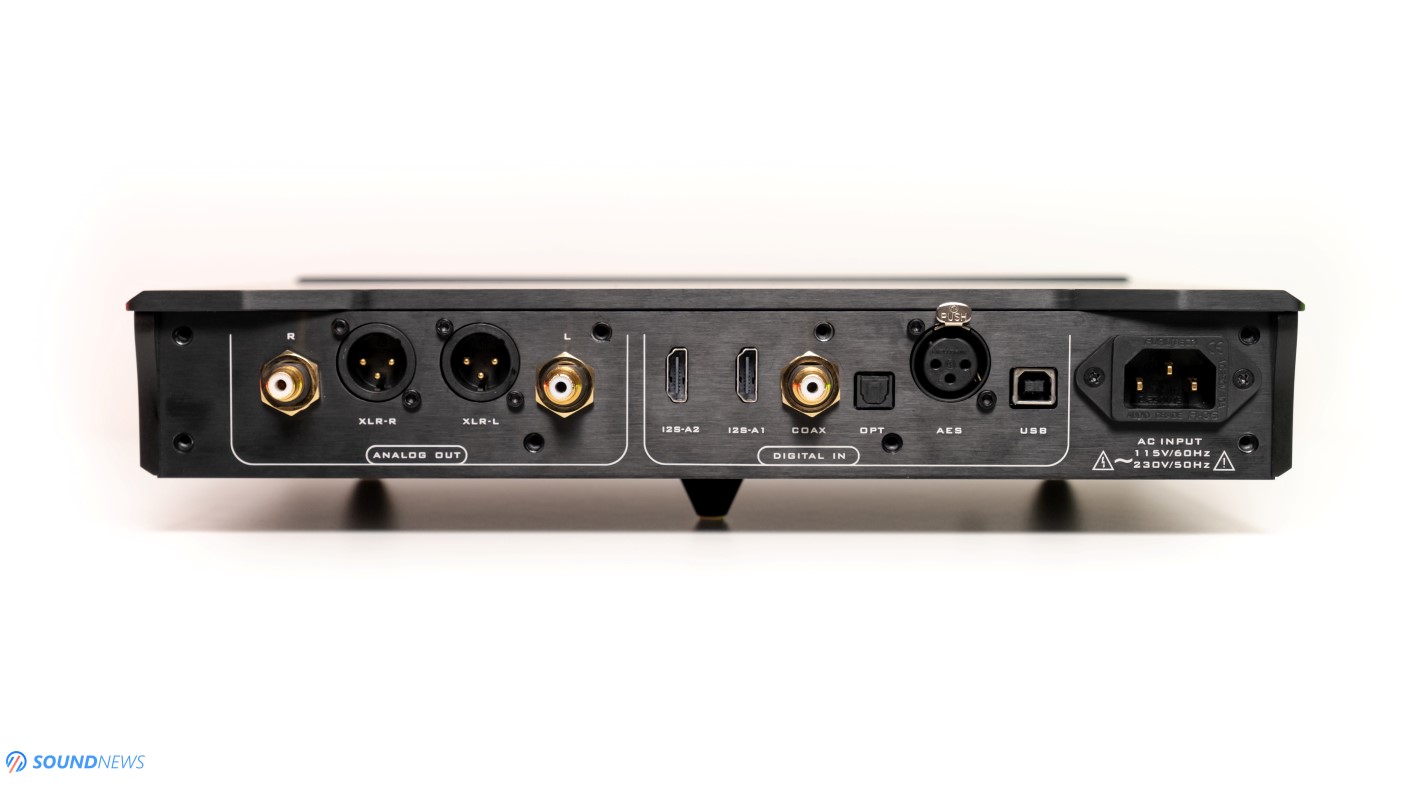
Controls & Connectivity
Aquarius is as simple and straightforward DAC as its founding father was one year prior. There are 7 buttons on its front panel, the one in the middle is your On/Off button, on its left there is your input selectors and a phase invert button. To its right there is a NOS (Non-Over-Sampling) button, its either On (Non-Over-Sampling is engaged on) or Off (Oversampling mode is engaged), followed by a Mute and Mode button. I will be testing its OS and NOS modes separately and will report back my findings.
On its back all the nicer digital inputs are present as USB, AES, Coaxial, Optical and two I2S inputs. Aquarius is a fully balanced DAC and as such it offers a pair of XLR and RCA analog outputs which have fixed volume levels. Its signal amplitude sits at 3.6V via XLR and 1.8V via RCA and if you need a little bit more, you can always add a Musician Monoceros into your rig.
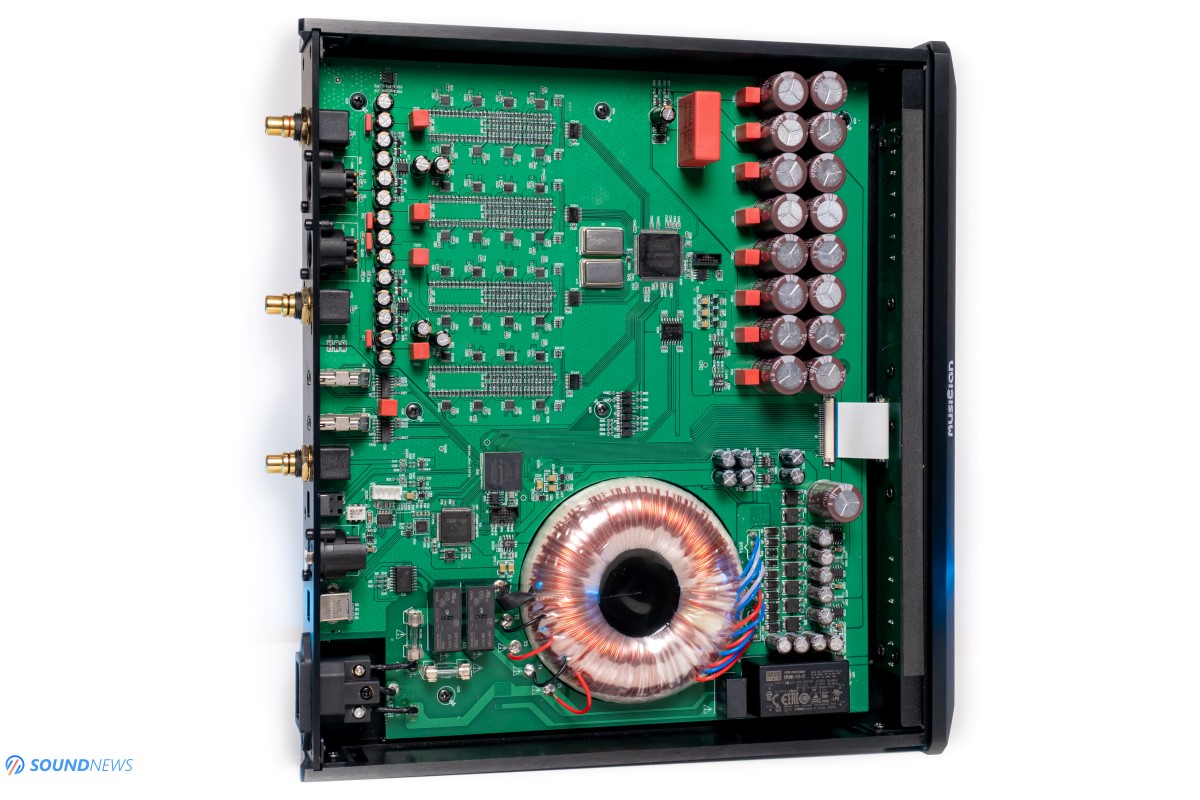
Under the hood of Aquarius
Considering the custom nature of all R-2R ladder DACs, you will hardly find two such units that are looking the same on the inside. I’m getting bored and quite fast looking at chip-based Delta-Sigma DACs, because most of them are looking the same under their hoods, with little to no differences. Taking a glance at Aquarius, I definitely see the Musician Audio signature so to speak, it reminds about Pegasus in a few key areas, but I see higher-quality components, a better capacitance, a bigger power supply and four ladders instead of two.
Most R2R DAC manufacturers aren’t using their own USB interfaces, with just a few exceptions. Usually, a board from third party companies is being used like Amanero Technologies, M2Tech, but most of them are using a time-tested XMOS interface like XU-208 or XU-216, which can be found in $200 to 20.000 DACs. Musician didn’t walk the same path, as Aquarius together with Pegasus are using a custom-made USB interface that uses the full-bandwidth of the USB 2.0 standard. This is a future-proof module that supports the highest possible sample rates as 1536 kHz 32-bit PCM and DSD1024 (x8). For such a small company…I’m impressed!
In an R2R ladder DAC, the audio signal is being converted from digital to analog by the help of ladders of resistors. The higher the precision of those resistors = a higher resolution could be obtained from the ladder. Musician Audio is acquiring thousands of resistors, from which a person measures and hand picks the best ones to be used in Aquarius. Only the ones that achieve a higher precision of 0.005% are being used in Aquarius. Hand picking and measuring resistors is a very tedious and time-consuming process, you can spot the same high-grade resistors in some of the best R-2R units of today. You can see the same resistors in fancier units like Denafrips Terminator Plus ($6500), but also in uber high-end converters. Musician wanted to offer the most life-like and believable sound that would stretch wide open, nicely filling the room with music and that is precisely why four R-2R ladders made their way inside, replacing two ladders on Pegasus. This is the main reason you are paying a premium for Aquarius.
The R2R ladder network is being controlled by an ARM CPU and by an Altera Cyclone IV FPGA infused with their own custom code that was tested and time-perfected for more than two years now.
On the analog side, Pegasus is using some of the best low-loss tantalum-polymer capacitors (the orange ones) that are typically found in very expensive designs. I’m seeing much higher-grade electrolytic caps as ELNA Silmic II, accompanied by WIMA reds which are also adding a high-end flare to this unit. I see plenty of voltage regulators from Analog Devices (those aren’t op-amps) and a complicated power supply. That O-type toroidal transformer is filtered two times. Just before it, two encapsulated regulators will be conditioning its AC voltage and after that juicy transformer, an additional voltage regulation stage will make sure its digital and analog stages are getting the cleanest possible power.
It is important to know that Aquarius is not using a single op-amp in its LPF (output stage), you can spot 8 discrete devices, the same that are powering their Pegasus, that already proved themselves as a powerful alternative to regular op-amps. As much as I’ve tried, I can’t see rushing inside, only a well-thought internal layout with extra care put into its power supply and ladder of resistors. Its capacitance seems much bigger to that of Pegasus, capacitor number doubled and that is a very comfortable sight.
The only downside I see with Aquarius, is that it will need double the burn-in time compared to Pegasus. Two weeks of non-stop burn-in were needed for its final form and if you’re wondering, I’ve been listening to it for about a month now.

Test Equipment
In my opinion, some technicalities are much easier to spot in a top-of-the-line headphone setup, especially detail-retrieval, transparency, transient response and frequency response are a child’s play for something like a Hifiman Susvara being driven by a power amplifier (Yes, you’ve read that right). In a loudspeaker setup it is much easier determining its soundstage size, depth and pin-location (imaging) of all the musical notes and that is exactly why Aquarius DAC was used in two distinct setups.
- In a desktop setup, Aquarius was connected to the Benchmark HPA4 preamplifier, followed by Benchmark AHB2 or KECES S300 power amplifiers, driving the most inefficient headphones, the legendary Hifiman Susvara. I’ve also tried the Hifiman HE1000SE, Audeze LCD-4, Erzetich Phobos and Kennerton Wodan. First ones for the sublime technicalities and detail-retrieval and later ones for outstanding bass performance and midrange presence.
- In a loudspeaker setup, Aquarius was connected to a Benchmark HPA4 or Topping PRE90 working as preamplifiers, followed by the same KECES S300/Benchmark AHB2 power amplifiers, driving a pair on KEF REFERENCE 3 and Natural Sound NS17 loudspeakers. Everything worked in balanced mode only, as Aquarius offers a nicer performance via XLR, plus a lower channel cross-talk and a higher dynamic range can be achieved only via XLR connection.
Okay folks, my ears are begging for some well-deserved music, so let’s hit some ear-drums!

Sound Performance
I. Preliminary Impressions & Tonality
With some particular units, burn-in wasn’t even needed, some needed only 2 to 3 days, some bigger units were more than okay after a week of music playback, but Aquarius is a (very) different beast. I’ll start by saying that Aquarius is by far the biggest shapeshifter I’ve experienced before and after burn-in. Musician Audio is recommending a week of burn-in and then specifies that 300 hours are actually needed. I don’t know how their math is working but 300 hours equals 12 days and a half and that was certainly the case with my unit. I’ve seen its last form and heard its last iteration approximately 2 weeks after non-stop music playback. You shouldn’t judge it immediately after powering it on, it will be a different beast altogether 2 weeks later.
At first, I couldn’t believe this is their flagship unit, I was disappointed, but hope didn’t leave my listening stop. Aquarius isn’t dissipating that much heat, it consumes only 12W from the wall and it’s barely warm at best, so I left it 24/7 in my secondary headphone setup, leaving a fresh new headphone do the same thing. The biggest let downs were dynamics…those were nowhere to the found and it had little to no bass authority at all. Even an entry level SMSL SU-8S that was sitting near it, sounded more engaging and alive. With Aquarius, everything felt cluttered and overcrowded, like all the notes were pushing each other, there was no air in the room, it didn’t breathe in my loudspeaker setup, it felt bi-dimensional and flat – opposed to how a proper R-2R unit should actually sound. A week later, the ugly duckling shown only a half of its beautiful face. Naturalness rushed it; voices were more pleasant, flowing like a river towards me, meat starting appearing on those skinny bones and from a shy sounding unit, I felt more power within that was still sleeping. Another week passed, I’ve prepared a glass of smoky whisky, I closed my doors and I focused all my attention on its music playback.
Thor Almighty! Aquarius transformed into a big, bold and extremely dynamic unit. Its two-week-old shackles shattered into small pieces, it was no longer shy and small sounding. There were bigger empty spaces between my music, everything was perfectly layered and positioned around me, finally there was an order in my music! Its soundscape stretched in all directions, it sounded bigger than my reference DACs sitting half a meter away from it, it was massive sounding and that was obvious even with flagship headphones. Besides a good flow that I’ve heard just a week ago, it added way more impact and a serious kick in the chest.
If you followed some of my DAC reviews, I’ve always complained that R-2R units cannot slam properly and deliver a lighting quick transient response. There was just one single R-2R unit that had a proper slam in the bass, holding its chin up and showing its muscle mass when heavy dynamic range tracks would appear on my playlist and that friends was Audio-GD R7 2020 Edition. Aquarius is very much the same, as it properly slams and pounds my body with an incredible force, it delivered lightning quick bass notes and it impressed an electronica addict. It lagged just a little behind that R7, but I kid you not, this is proper bass that has quality and quantity, something that not a lot of R-2R units can be proud about.
When old-rock tunes started playing, I’ve observed that cymbals sounded like drum sticks were hitting round pieces of brass, not like smashing glass into million pieces…as it could sound on several delta-sigma units. I could feel their metallic surface, I felt their body and I’ve experienced believable cymbals, exactly as they are sounding in real life. There was speed, impact and natural textures. There was another huge surprise, which I’ll leave for the chapter 3. Make no mistake, Aquarius story just started and there is a lot more to it.

II. Using Musician Aquarius in a loudspeaker setup
Aquarius, as Pegasus and as any other R-2R converter I’ve tested up to this point, doesn’t have preamplifier functionality and there is no way to control its volume, as it always outputs a steady 3.6V on its XLR output or a much lower 1.8V on its RCA output. To be used with your speakers, you’ll need an integrated amplifier or if you want to go the high-end route: you’ll need a preamplifier and then a power amplifier. I’ve used two preamplifiers with it: my daily-driver Benchmark HPA4 and then a Topping PRE90, controlling two very distinct power amplifiers: a warm and natural sounding Keces S300 and then a super-honest and extremely clean sounding Benchmark AHB2.
If you check the latest affordable oversampling DACs with delta-sigma modulators, you’ll observe that almost all of them have a volume control, bypassing the need of a dedicated preamplifier (line amplifier). However, most of these units are using very simple digital attenuators to reduce their voltage and subsequently their volume output, they don’t have actual line-amplifier circuits inside or a very precise volume attenuation, downgrading the final outcome when driving power amplifiers. Those units will be lacking speed, impact, as they can’t control speaker diaphragms as good as a dedicated preamplifier would do. If I would choose between a DAC with a fixed voltage versus one that has a mediocre volume attenuator and no line-amplifier circuits, without second thoughts I would take the first option. Lacking of volume wheel isn’t a huge drawback, as you can add an affordable preamp like Topping PRE90, you can go with their Musician Monoceros, you can go with a super-transparent Benchmark HPA4, or you can add even more soul and smoothness in your setup by the help of a tube preamplifier. All these options, would not sacrifice driver control, transient response and subsequently sound quality. If price is no object, then there are DACs with proper line-amplifier circuits, where a dedicated preamplifier wouldn’t help that much, but those units start at around $3400 and could reach stratosphere prices in a blink of an eye.
Aquarius sounded as if I had no walls in my room, pulling and pushing more air between the notes, adding space where there was none. it sounded bigger, wider and deeper to all my converts, including the Matrix Audio Element X, Gustard X26 PRO and Audiobyte HydraVox. In my headphone setup, it mildly increased the stage size, but that was a very different story in the living room. Music flown towards me like a river, it sounded more real to everything I have around me, it was just by a hair warmer and more natural sounding to that Gold Note DS-10 Plus and it was as impactful and clean sounding as the Gustard X26 PRO. In all fairness, I liked its performance in my loudspeaker setup by a lot more.
Aquarius never pressed the brakes, on the contrary, dynamics were going up and down and nothing would stop those notes from reaching their peaks. It was highly engaging, toe tapping at all times and sometimes even explosive. Its minuscule midrange and mid-bass boost worked outstanding with the Benchmark HPA4 + AHB2 combo, adding some character and meat to the bone to a dead-neutral setup. There were layers after layers of music and since there was so much air traveling around, I could easily focus on any musical note. There was a tight control with my loudspeakers, I didn’t experience flabbiness with my electronica music. What more can I say? It surpassed my wilder dreams and it performed flawless in a loudspeaker setup. It was both technical, clean, but also musical sounding. I wasn’t listening to random sounds anymore, I was listening to music as the final outcome awake more emotions, making me move to rhythm of the music.

III. Detail Retrieval & Transparency
You know what’s weird and unusual with Aquarius? It’s so incredibly clean and highly resolving, easily highlighting all the tiniest details and it is such a natural at doing all this. Those hand selected resistors and of course those femto-second clocks leveled-up its Sherlock Holmes skills to 120. I was blown away…. I shook my head and took a step back to re-evaluate it with a lot more reference recordings. I have to admit that I had some doubts about it versus some of my time-tested top-of-the-line oversampling converters. I expected a decent to great detail-retrieval with little to no leading edges, but boy…I was all wrong.
After a few hours of non-stop music listening, comparing it back and forth with some of the best converters I had on my hands, I started heavily sweating…as in terms of sheer resolution there were little to no differences at all. Aquarius was more of less on the same level with Element X and X26 PRO and mind you…those are some highly resolving D/A converters, easily pulling out the smallest and the lowest intensity notes even at low volumes. Imagine my awe and shock when Aquarius sounded as clean, exactly as contoured, offering heavy textures on the inside and clean defined contours of the outside. My past R-2R experiences were all about liquidity and naturalness and less about the skills and technicalities that Aquarius is providing. If being completely honest, mid to top-level oversampling DACs will easily outperform several R-2R DACs, with a few exceptions of course, but the same rule doesn’t apply to the Aquarius, it is something else entirely. I would describe it as having all the positives and none of the negatives of those DACs. It has musicality, fullness on one hand and a high resolution on the other hand. It is usually one or the other, but never both.
This is one hell of a clean sounding unit; it will be outperforming even great measuring delta-sigma DACs. It is extremely satisfying hearing so much more of everything hidden in my tracks that I know for a lifetime. There isn’t just a wall of sound, there’s ebb and flow, there is plenty of space between each and every musician, flexing and weaving together without pushing anyone out of the sonic picture. Micro-details were aplenty throughout intricate grooves and stunning solos.
What’s more important than ever is that those details aren’t hollow and empty, those are full of life, there is always some added weight, there were moments of energy spikes, dynamics were through the roof, constantly inter-playing with the listener. There was a pulse and a heartbeat with my music, more so to any other converter I’ve tried in my house, which isn’t something easy to write…especially for a unit that should go back in a few weeks. Aquarius is quite a special R-2R DAC as it was able to awake positive vibes, while keeping a highly transparent nature of top-of-the-line oversampling converters.

IV. Transient Response
Believe it or not, this part alone is the most important aspect of all ladder DAC units. Some R-2Rs that passed through these hands were mighty impressive in the slam department (Audio-GD R7 was one of the most impressive in there) and not so much when it comes to speed. I like mellow and relaxed music myself, but sometimes I want to raise my dopamine levels and I can do that only with fast, impactful tunes and that is precisely why a TOTL oversampling DAC will always be at my side no matter what. Usually, R-2R units are gently pressing the brakes, never going in and out in a split second, there is a decent acceleration, but there is never a need-for-speed. There are several exceptions to this rule, Rockna Wavelight is probably the best example I can give. It is incredibly fast and hard punching, always keeping up with the most demanding tunes. That one is a transient response monster and doesn’t need additional help, but if I’m adding a snappy and nimble sounding preamplifier like the Benchmark HPA4, then Aquarius transforms into an untamed wild mustang roaming the fields. I like the way Musician tuned this one, going for a deeper bass response, that feels faster and clearer sounding compared to their Pegasus, which was great in here, but not really amazing.
I waited for two painful weeks, before it started showing me unlimited bass depth, that was textured, heavy weight, but also fast sounding. In all seriousness, Aquarius is very impressive when it comes to speed and slam. If you put it into OS (Oversampling) mode, then it goes even faster, sacrificing just a little bit of liquidity, in favor of clearer leading edges and of a faster pace. I’m engaging OS mode only with electronica & rock music and with everything else I’m staying on its NOS mode. Its Sharp and Slow filter didn’t make that much of a difference as far as speed and impact are being concerned, there is only a slight difference in the upper treble roll-off. Slow filter extends a little over the top octave and Sharp filter cuts its treble output at around 20 kHz.
Shroomeez by Infected Mushroom (Qobuz / Tidal) is so far my number one EP of 2021. I’m using this 4-track masterpiece to check the speed and impact of all my equipment. This is a very complex journey through rhythmic beats, instrumental solos that are both organic and extremely precise sounding. Those relentless bass lines and heavy riffs offered moments of contemplation, this is psytrance at its finest. You won’t find a moment that is boring or that isn’t pressing the pedal to the floor with Aquarius. Forget about catching your breath, this is pure raw dopamine, pushing and pulling you like a rag doll. Aquarius never lost a beat; it presented this album with utmost control and authority in the bass.
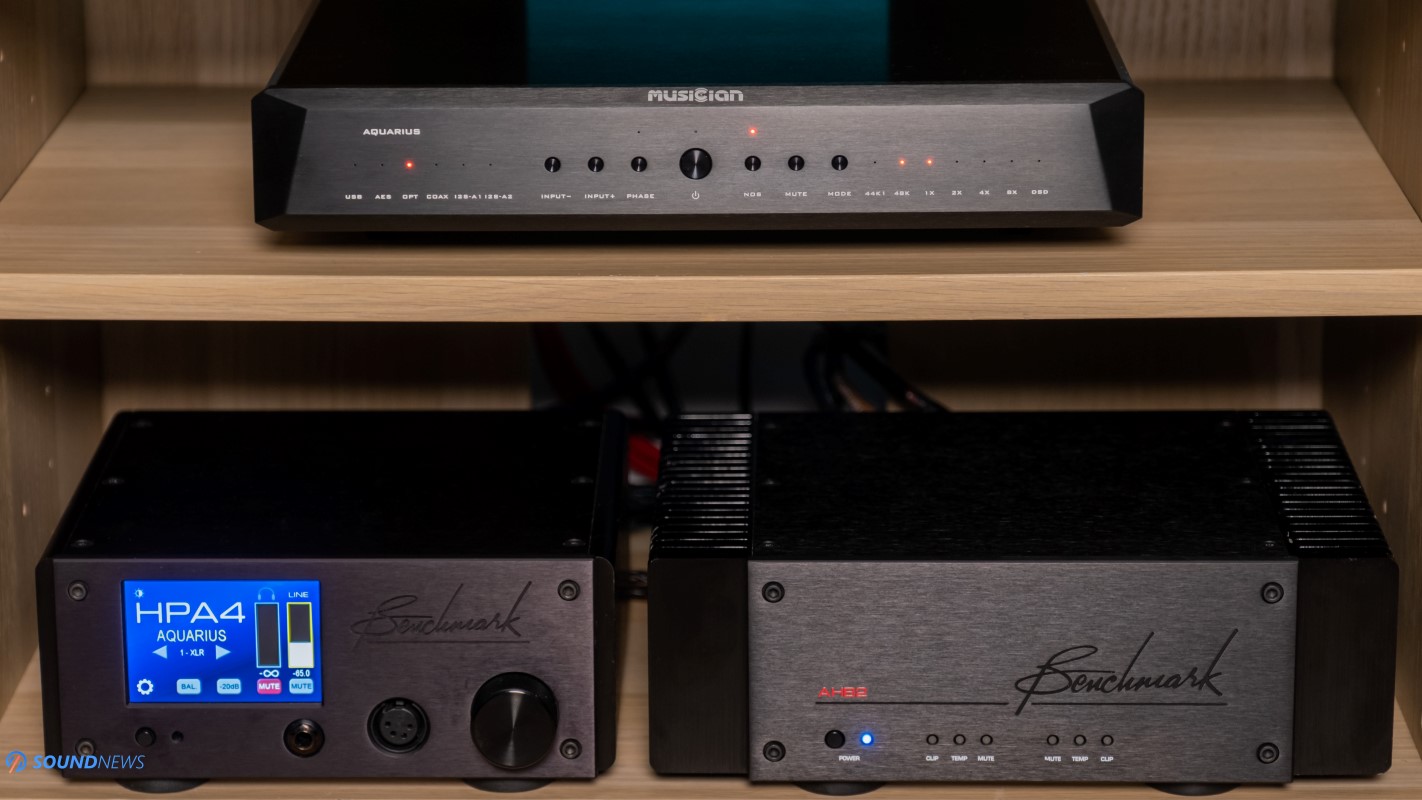
V. Soundstage & Depth
It isn’t a novelty to anyone that R-2R units are expansive and big sounding all the time, but the ones that use a powerful output stage and a healthy capacitance are unlimited as far as soundstage goes, those are deeper and even wider sounding. Musician team put a bigger accent on its power supply, on its filtering stages and it really shows while listening to it. I’m experiencing a big difference in my loudspeaker setup, where some of the music felt unrecognizable, transforming into some sort of 3D audio trickery, with notes coming from awkward angles towards me. There is more air hidden between the notes even compared to a Gold Note DS-10 Plus and Matrix Audio Element X and mind you, those already sounded mighty impressive in here. Connected to a Benchmark HPA4, followed by a Benchmark AHB2 or Keces S300 power amplifiers, it is like someone secretly swapped my KEF Reference 3 with bigger Reference 5 loudspeakers. There was more of everything in the room, as I was picking up notes from thin air as cherries from a tree, I felt enveloped by music as if it was hugging me.
Moving to a headphone setup, the soundstage increase to my own converter wasn’t that big due to the nature of headphone listening itself, but still, the whole experience felt more holographic, music wasn’t pushed inside my head anymore, I was at peace and I felt more relaxed as it pushed all that energy around me. Even those tiny IEMs, started sounding like some semi-open desktop headphones. Aquarius impressed me with its depth, it was uncommon hearing deep reaching sounds, well spread across my listening spot with a pair of Hifiman HE1000SE. Even with drivers sitting inches away from my eardrums, it fully preserved its airy and clean nature, expanding wide open and uncluttering all my music.
An Innocent Man by Billy Joel (Qobuz / Tidal) is on constant rotation when I’m checking the stage size of my equipment. I’m genuinely liking this album, but the title song is a true masterpiece as it migrates from a simple bass and treble arrangement, into a majestic ensemble as it reaches its climax. Joel is very impressive as far as dynamic range goes, reverb on the snap trails is a little longer, and every echo is perfectly captured, improving the perception of air traveling in the room. The overall imaging of this song really shows what the Aquarius is capable of. The separation among instruments really helps tighten the song in some ways; Aquarius really flexes its muscles on this track, it’s impressive.
Child in Time by Deep Purple (Qobuz / Tidal) is a timeless track and a true staple in their concert repertoire no matter the lineup. Going over 10 minutes, Aquarius really showcased the band’s virtuosity and musical brilliance. From blistering guitar solos, to powerful high-pitches screams, Aquarius highlighted every member’s mastery. I was impressed by how much more air there was between the electric guitar on the right to the bass guitar on the left. Notes were bouncing through the walls, filling the room immediately with sounds and positive vibes. Layering was outstanding, leading edges were clear and there was a defined instrument separation, shining the spotlight on each one of them. I couldn’t ask for more.

VI. Noise Floor
In a loudspeaker setup Aquarius was driving a preamplifier, followed by a power amplifier of my choice and then by a pair of KEF Reference 3. That worked impressively well, as it was completely noiseless on the XLR output. I didn’t hear hissing or disturbing noises at higher volumes. KEF’s UNI-Q coaxial drivers are extremely sensitive to noise coming from upstream equipment, those can pick-up residual noise from lower quality sources and amplifiers, but luckily that didn’t happen. Musician Audio Aquarius didn’t put nasty gremlins in the background and as far as noise floor goes, it can’t be cleaner than that.
Putting it in a headphone setup, connecting a Benchmark HPA4 and then driving several pairs of ultra-sensitive IEMs, portable over-ears and low-impedance planar-magnetic headphones didn’t ruin its reputation, as background remained as clean and noiseless as it was with loudspeakers. I went through several albums and arrived at the same conclusion, that it was a clean sounding unit with headphones and loudspeakers alike.
Dynamics were swinging up and down, music was hitting me hard, putting a huge grin on my face. Even going louder to my usual listening volumes, everything remained tightly controlled, clean and defined, without losing inner detail or crispness. In this regard, it behaves as a high-performance and noiseless DAC, so no complaints in here.
Considering its well-designed power supply, I would be surprised hearing anything less than an immaculate performance in terms of noise floor. Adding a cell phone on top of it, didn’t add hum/hiss and all I’ve heard was a clean, undistorted sound. Background noise was nowhere to be spotted, it was as black as it could possibly be and no matter if I would be using headphones or speakers, I knew that I can rely on its noiseless performance.

VII. Frequency Response
Two weeks ago, I was booing its thin and lifeless presentation, it had little to no bass texture, dynamics were missing in action, it couldn’t land a punch even with modern electronica. As wine taste better with age, Aquarius changed its character to unrecognizable and it settled down at around ~330 hours of use.
A. Bass
When it comes to bass, from the entire R-2R army of DACs I’ve listened to, Aquarius together with Audio-GD R7 are the strongest candidates. Its low-end is calm…as a bomb. It’s juicy, bold and easily reaches the lowest pits of the sub-bass. Compared to an entry to mid-level DAC, at first it might appear as there is more bass presence, but no…this is how proper bass should be played, maintained and decayed. There is as much texture, warmth and presence as you could possibly desire. I’m not sure where it’s coming from, but it is there in spades. It is highly detailed, it’s very fast, it pounds impressively and it decays at the right time. Be it mid or sub-bass, Aquarius sounded layered, effortless and detailed, without a trace of distortion. Aquarius feels like a big departure from Pegasus in terms of bass quality and quantity and a much bigger one from Denafrips offerings that I’ve tried in the past. In all fairness, Aquarius is a transient response monster, thanks to an immaculate bass reproduction down to the smallest nuances. No matter if you are listening to your regular jazz or classical pieces, you’ll be surprised by how much more low-end Aquarius will be able to pull-back from your tunes, there is always a bass note lingering somewhere and it can’t hide from its gaze. There is plenty of flow and easiness in the bass, but also boldness and lots of technicalities.

B. Midrange
This is pretty much the biggest reason you are interested in a R-2R DAC. Sure, there are some oversampling DACs that are doing their best in reproducing the midrange as natural and as organic as possible, but R-2R units are doing this by default without flexing their muscles. I can mention several oversampling DACs that are pretty good in here, but R-2R units are all very impressive in here. Some are putting more meat to the bone; others are pushing the vocals more forward. Aquarius isn’t doing all this, it is still a very linear DAC top to bottom, it doesn’t emphasize anything, it tries to be as detailed as possible, while retaining the organic nature of your music. I wouldn’t describe it as warm or meaty sounding, Aquarius is more about being honest, fully preserving the weight, the innards and the naturalness of the notes happening in this region. Midrange comes in right doses and it feels life-like and natural, nothing is boosted or taken away. Forget about thinness or dryness, there is nothing of that in here. Aquarius is full of life, always trying to impress with its rightfulness and precision. There is nothing of that mellow or slow character of entry to mid-level DACs, as Aquarius is a nimble, wild horse. It will keep it with the fastest tunes, sending shivers through your spine. I’ve listened to several rock and jazz albums and I couldn’t get enough of it, it just sounded right from the get go, nothing more and nothing less.
C. Treble
Describing its top end is complicated, because on one hard there is as much treble presence, detail, shimmering and as much information as you could want…but there is no listening fatigue, none! I’m hearing the brass crashing and shimmering when cymbals are being hit, bells are ringing loud and clear, without wanting to lower its volume. There is energy in the treble, there is micro-detail even past top-octave, but all that comes without sacrificing anything. You can listen to your rock and metal at higher volumes, without experiencing ringing in your ears. Aquarius possesses that special recipe that oversampling delta-sigma DACs are never getting it right. You know what’s funny? I’ve put it back in my headphone setup, I’ve added that HPA4 working as a pre, added the AHB2 working as a power amplifier and I’ve drove those Hifiman Susvara with a huge grin on my face. You see, HPA4, AHB2 and Susvara are very and I mean very detailed and transparent sounding units, those are my truth tellers and if something is not quite up there with the best, those will be telling me that in a few seconds. I didn’t experience shrillness or brightness with that setup, I just wanted to listen to more music and rediscover that organic sound that my own converters can’t render that well. I’ve listened mostly to rock and jazz, I wanted to playback all my childhood albums, with some tunes it would highlight the bass notes and add a different meaning to it, in other tunes it would bring goose bumps all over my body due to an outstanding reproduction of the human voice and in other tunes it would show the beauty of cymbals and tambourines, without sacrificing details and without lowering my volume levels. It was always on top of its game, tightly controlling every musical note, being a gentle giant with smoother music and a ruthless beast with some other tunes and you know what? I love it for that. It was running in circles around my DACs, as it could provide cleanness, details, transparency, but also organic textures and natural decays and I wish all my DACs would sound this way.
Overall, I wouldn’t describe it as warm, thick, meaty, bright, lean or mellow sounding, it doesn’t have any of that. I would describe it as real sounding, true to the recordings, as life-like as music sounds in a cozy jazz venue and this is everything you need to know about it.

My conclusion
Sometimes there are units that are leaving me speechless and Aquarius seems to be part of that exclusive crowd, so much so that I’ll probably sell plenty of my converters and get a single unit as this one. I’m chasing for transparency, linearity and detail retrieval for my whole life, I want the most extended frequency response, all while being organic and real sounding. I want it all and I want it in the same package, but that felt like being Don Quixote fighting windmills. I could see the light at the end of the tunnel, but there were always compromises down the road. The only compromise I see with Musician Aquarius is that…it’s only a DAC, nothing more and nothing less. Lucky me, I’m having two preamplifiers, so I can easily integrate it into a stereo setup, unlucky you, a preamp would be mandatory, or just stick with integrated amplifiers. As far as technicalities are being concerned, it had everything dialed up to eleven and a little bit more. It will impress the most with its highly layered and extended presentation, then some organic matter will crawl into your tunes and much later on dynamics and bass texture would make a glorious appearance in your music. When that happens, there is nothing more to complain about it. It sounds like real music that is being played right now in front of you, not like a soulless amalgam of sounds ‘n’ noises and this is the biggest compliment I can give to Musician Aquarius.

Gold Award is fully deserved and there is no doubt in my mind that it performs like a high-end piece of equipment. Musician Audio please don’t stop here, I’m starting to feel a distinct signature with all your devices and I really like their tuning.
Musician Aquarius is a no-compromises R-2R ladder DAC and as such it was priced accordingly. As of right now, you can get it only from their sole world-wide distributor Aoshida-Audio, you can check their web-store right here. $2899 are a lot of Benjamins, but you are getting a proper service and free-worldwide shipping, which makes that a sweeter deal.
In case you are getting one for your stereo or headphone setup, please leave a comment below and tell us how it performs with your gear and music collection.
PROS:
- Massive and solid looking
- Top-notch build quality
- Impressive part selection down to the smallest details
- A wide-open soundstage that has no bounds or borders
- Holographic, layered and 3D sounding all the time
- So far, this is the cleanest sounding R-2R ladder DAC I’ve experienced, offering gobs of micro-details
- Mostly linear sounding, extended frequency response with zero roll-offs
- Slams and pounds like a gorilla, goes in and out instantly – impressive transient response
- Forget about a noise floor with it
- Engaging and toe-tapping, impressively dynamic
- Organic, full-bodied and life-like sounding
- Widest selection of digital inputs
- Good price for an immaculate performance
CONS:
- It is only a DAC, doesn’t have additional features
- Long burn-in time
- Pricey
ASSOCIATED EQUIPMENT:
- DACs: Musician Aquarius, Rockna Wavelight, Audiobyte HydraVox & HydraZap, Matrix Audio Element X, Gold Note DS-10 Plus & PSU-10 Evo, Gustard X26 PRO, X16, Topping D90SE
- DAPs: FiiO M11 Plus LTD, M15, Shanling M8, M6, M3X
- Headphone Amps: Benchmark HPA4, Singxer SA-1, Flux Lab Acoustics FA-10, Burson Soloist 3X, Musician Andromeda, SMSL SP400, Topping A90, Gustard H16
- Power Amps: Benchmark AHB2, KECES S300, SMSL SA400
- Loudspeakers: KEF Reference 3, Natural Sound NS-17
- IEMs: FiiO FA9, FH7, FH5S, FD5, Meze Rai Penta, Rai Solo, LittleDot Cu KIS, Hiby Crystal 6 & others
- Portable headphones: Sennheiser Momentum 2, Meze 99 Classics
- Full-sized headphones: Hifiman Susvara, HE1000SE, Arya, HE400SE, Audeze LCD-4, Erzetich Phobos, Erzetich Mania, Kennerton Wodan, Magni, Gjallarhorn, Vali, M12S, Ollo S4X Reference & others
- Interconnects: QED Reference (x2), Topping TCX1 (x2)
- Speaker cables: Kimber PR8, Audioquest Type4
- Power Cables: Isotek EVO3 Premier (x3)
- Balanced Isolation Power Conditioners: PLiXiR Elite BAC1500, Elite BAC400


